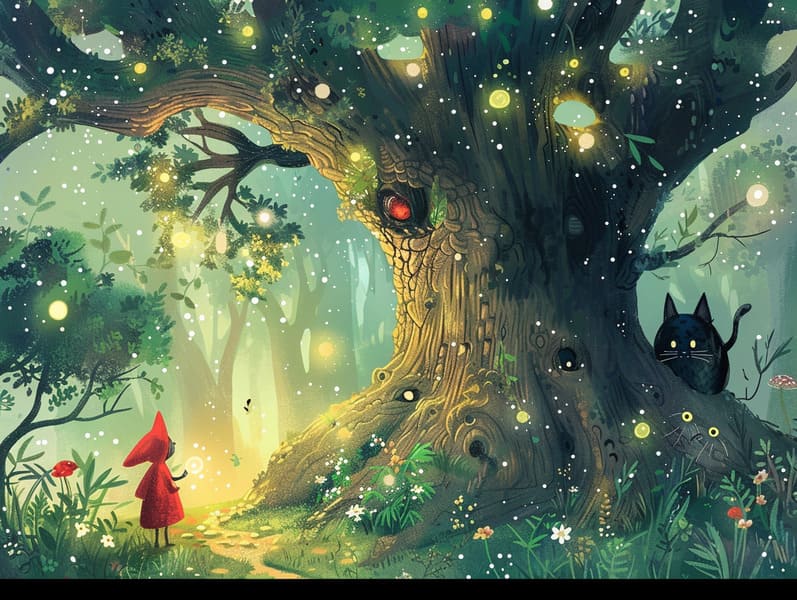
Famous fairy tales have legendary status. These narratives have been recounted from one generation to the next long before they were ever put on paper. They developed from a variety of societies, including Eastern traditions. They were initially told among adults, often carrying themes and messages reflective of the societal norms and beliefs of the time.
Jacob and Wilhelm Grimm, Jacob and Wilhelm Grimm, were among the first to compile and publish many of these beloved narratives. Their published works, "Grimm's Fables," included narratives like "Ashenputtel," "The Story of Hansel and Gretel," and "Snow-White and Rose-Red," which have since become cornerstones in the world of traditional fairy tales. Similarly, H. C. Andersen's fanciful narratives, such as "The Story of the Little Mermaid," and "The Little Duckling," have gained the love worldwide, securing their place in the pantheon of treasured fairy tales.
Despite being ancient, classic fairy tales remain as applicable as ever, especially as nighttime stories for kids. These enchanting tales are now available in multiple formats, including colorful picture books, delightful animations, and web-based fairy tales.
Their continued relevance can be linked to several charming aspects:
Life Lessons: Classic fairy tales often impart important moral lessons. Tales like "The Wolf and the Liar" teach the value of sincerity, while "The Tale of the Tortoise and the Hare" demonstrate the benefits of perseverance and modesty. These narratives offer the young clear distinctions between virtue and vice, guiding their moral compass in a mild yet lasting way.
Compassion and Knowledge: Classic fairy tales frequently include characters facing trials and tribulations, motivating kids to understand with their struggles and rally behind their triumphs. For instance, "Beauty and Her Beast" teaches us the necessity of looking deeper to recognize the inner being of a being, nurturing understanding and perception.
Cultural Perception: Many fairy tales are rich in the cultural contexts from which they came. Learning from these narratives can provide captivating looks into different backgrounds, strengthening a sense of cultural insight and discernment.
Creativity and Imagination: The extraordinary elements in ancient fairy tales—magic wands—unleash children’s imaginative ideas. These stories bring readers to mythical realms, unleashing creative dreams and a sense of magic that continues a lifetime.
Timeless fairy tales are not only alluring but also pedagogical. They act as mesmerizing tools in strengthening various intellectual and emotional capacities in the young. When traditional fairy tales are told out loud, they boost language acquisition by offering new terms and complex sentence structures. This practice also develops auditory skills and attention span, as the young track the narrative, eager to see what happens next.
Furthermore, deliberating the themes and characters of fairy tales can nurture reasoning skills and intellectual skills. Little ones are led to see patterns, predict happenings, and understand cause and effect. These debates also aid the young reveal their thoughts and feelings, boosting their emotional intelligence.
In today’s online age, the abundance of digital fairy tales has made these stories more obtainable than ever. Digital sites and programs offer extensive collections of famous fairy tales that can be read or listened on anytime, anywhere. Fairy tales told out loud are particularly prevalent, featuring an interactive way for the young to appreciate these mesmerizing stories. Narrated books and read-out-loud videos carry characters and settings to life, often supplemented by charming audio effects and instrumentals that elevate the tale-telling adventure.
The timeless appeal of ancient fairy tales lies in their ability to shift to the present while keeping their central values. Contemporary reinterpretations of these stories often spotlight more different figures and modern settings, making them pertinent to today’s audience. However, the core values of valour, kindheartedness, and fair play remain unchanged, continuing to impact readers of all ages.
Fairy tales also offer a sense of solace and homeliness. They afford a coherent narrative with a obvious beginning, middle, and end, often wrapping up with the settlement of conflicts and the triumph of truth over falsehood. This foreseeability can be these guys heartening for kids, allowing a sense of unwaveringness in an unstable world.
Ancient fairy tales continue to allure and inform new generations, maintaining their fascination and applicability in modern society. As nighttime stories for kids, they bestow a perfect blend of wonder and wisdom, cultivating moral values, empathy, and creativity. The existence of online fairy tales and the likability of fairy tales read aloud certify that these classic narratives remain reachable to new generations.
By sustaining and broadcasting these fairy tales, we continue to commemorate the rich tapestry of tradition and cultural heritage. Whether you are experiencing a beautifully illustrated book, experiencing a digital collection, or playing an voice book, the spell of timeless fairy tales is always within reach. These tales demonstrate of the persistent impact of stories and its ability to unify us across time and space.
Whether you are experiencing a richly illustrated book, perusing a internet collection, or listening via an read-aloud book, the captivation of children's fairy tales is always within reach.
These narratives illustrate of the invariable essence of tales and its ability to tie us across time and space, forging a link that captivates and teaches alike.